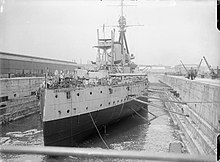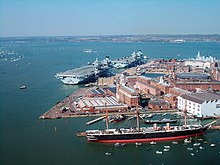HMNB Portsmouth
[2] From the 1970s, the term 'Naval Base' began to be used for Portsmouth (and other Royal Dockyards), acknowledging a greater focus on personnel and support elements alongside the traditional industrial emphases.[7] The base is additionally home to a number of commercial shore activities, including the ship repair and maintenance facility operated by BAE Systems Maritime Services.These privileges were inherited by the Commander-in-Chief Naval Home Command (whose post was combined with that of Second Sea Lord in 1994), who continued to fly his flag from HMS Victory until 2012.Once HMS Lancaster completed her Persian Gulf deployment in 2025, it was expected that she would decommission thus ending the basing of Type 23 frigates at Portsmouth.In 2015 an architectural design competition for the project was won by Latz+Partner;[26] however, the Ministry of Defence subsequently indicated that property to the north of the Mary Rose will not be ceded for several years at least, due to the site's proximity to the berth of the new Queen Elizabeth-class aircraft carriers.Edward II ordered all ports on the south coast to assemble their largest vessels at Portsmouth to carry soldiers and horses to the Duchy of Aquitaine in 1324 to strengthen defences.[31] Contemporary records suggest that the dry dock was enlarged and rebuilt in 1523 in order to accommodate the Henry Grace à Dieu (the largest ship of the fleet at that time); but a hundred years later it is described as being filled with rubble.[32] Following the establishment of Chatham Dockyard in the mid-1500s, no new naval vessels were built here until 1648, but ships from Portsmouth were a key part of the fleet that drove off the Spanish Armada in 1588.[35] By 1660 the dockyard had, in addition to these large-scale facilities for shipbuilding and repairs, a new rope house (1,095 ft (334 m) in length) and a variety of small storehouses, workshops and dwellings arranged around the site, which was now enclosed by a wooden palisade.[36] Between 1665 and 1668 Bernard de Gomme fortified the dockyard with an earthen rampart (complete with one bastion and two demi-bastions), as part of his wider fortification of Portsmouth and Gosport.[6] The rest of the reclaimed land was given over to storage space for timber with saw pits and seasoning sheds alongside, as shown in the dockyard model of 1774.[52] After the old Commissioner's House had been demolished, four identical quadrangular buildings were built, flanking the timber ground east of the Basin; as well as providing storage space, they accommodated workshops for a variety of trades, including joiners, wheelwrights, wood-carvers, capstan-makers and various other craftsmen.A prolific inventor and precision engineer, Bentham's initiatives at Portsmouth ranged from instituting new management principles in the manufacturing departments to developing the first successful steam-powered bucket dredger, which began work in the harbour in 1802.His plan was that the engine should be used not only to drain the reservoir (by night) but also to drive a sawmill and woodworking machinery (during the day); he also envisaged linking it to a freshwater well, to enable water to be pumped through a network of pipes to various parts of the dockyard.A table engine, designed by Bentham's staff chemist James Sadler, was installed in 1799; it represented the first use of steam power in a Royal Naval Yard.Having been presented with Brunel's designs, which would be built by Henry Maudslay, Bentham incorporated them into his woodworking complex and linked them to the engines by way of line shafts.In 1805 Horatio Nelson toured the newly opened block mills before embarking from Portsmouth on HMS Victory, leaving Britain for the last time before his death at the Battle of Trafalgar.The Steam Factory, on the western edge of the basin, housed a series of workshops: for construction and repair of boilers, for punching and shearing and for heavy turning; there was also an erecting shop for assembling the finished engines.[64] The infrastructure and buildings were designed by a group of Royal Engineer officers, overseen by Captains Sir William Denison and Henry James.[65] In 1867 a very large Armour Plate Workshop was opened, filling the space between the new North and South dry docks on the eastern side of the basin.[67] Three dry docks were also constructed as part of the plan, as well as parallel pair of sizeable locks for entry into the basin complex; the contemporary pumping station which stands nearby not only served to drain these docks and locks, but also delivered compressed air to power equipment around the edges of the basins:[68] five cranes, seven caissons and forty capstans were run on compressed air from the pump house.[36] Before the end of the century, it was recognised that there would have to be still further expansion across all the Royal Dockyards in order to keep pace with the increasing likely size of future naval vessels.[71] A small railway station and ornamental cast-iron shelter served in particular the needs of Queen Victoria and her family, who would often transfer from yacht to train at this location; this line soon became the main arrival/departure route for personnel.Dry-docking provision was further increased in 1912 through the addition of an Admiralty Floating Dock, large enough to accommodate a dreadnought, which was moored just off Fountain Lake Jetty.In accordance with the Government's Ten Year Rule the Dockyard worked over the next decade and a half with a presumption of enduring peace rather than future conflict.In response a task force of British military and merchant ships was dispatched from Portsmouth Naval Base to the islands in the South Atlantic to reclaim them for the United Kingdom.[35] The dockyard's 'Edwardian piece de résistance', the Great Factory of 1905, ceased manufacturing in 1986 and was converted to serve as a warehouse (at the end of the century it was linked by monorail to other nearby buildings to create a large Central Storage and Distribution Facility).[90] In 2007 it was reckoned that the Royal Navy/MOD directly employed 9,774 people at Portsmouth, of whom 5,680 were ships' crew and the rest either service personnel or civilian employees working in the naval base.Construction of modules for the Type 45 destroyers and Queen Elizabeth-class aircraft carriers took place here, latterly under BAE Systems Maritime – Naval Ships.These fortifications required substantial numbers of personnel to man them and, from the mid-18th century onwards, they (together with other troops who were either stationed in the garrison or preparing to embark overseas) were accommodated in a variety of barracks in and around the city.













































Portsmouth Naval ShipyardPortsmouthHampshireMinistry of DefenceDefence Equipment and SupportRoyal NavyInternational Festivals of the SeaCommodoreHMNB ClydeHMNB DevonportPortsmouth HarbourSolentIsle of WightRoyal Dockyardstate-ownedwarshipsRoyal Navy surface fleetHMS Queen ElizabethHMS Prince of WalesNavy Command HeadquartersBAE Systems Maritime ServicesSenior ServicedrydocksBlock MillsRoyal Naval MuseumPortsmouth City CouncilPortsmouth Historic DockyardMary RoseHMS VictoryHMS WarriorNational Museum of the Royal NavyKing's Harbour MasterDockyard Port of PortsmouthSemaphore TowerGeorge ZambellasCommander-in-Chief, PortsmouthflagshipCommander-in-Chief Naval Home CommandSecond Sea LordFirst Sea LordHenry LeachWhale IslandFleet CommanderType 45 destroyerHMS DaringHMS DauntlessHMS DiamondHMS DragonHMS DefenderHMS DuncanType 23 frigateHMS LancasterHMS ArgyllHMS MonmouthHMS MontrosePersian GulfHunt-class mine countermeasures vesselHMS LedburyHMS CattistockHMS BrocklesbyHMS Middleton9 Mine Countermeasures SquadronHMS JufairHMS ChiddingfoldHMS HurworthRiver-class patrol vesselHMS TyneHMS SevernHMS MerseyHMS ForthHMS MedwayHMS TrentHMS TamarBritish Defence Singapore Support UnitHMS SpeyCutlass-class patrol vesselHMS CutlassGibraltar SquadronHMS DaggerArcher-class patrol vesselHMS BlazerHMS ExploitHMS PuncherHMS RangerHMS SmiterXV Patrick BlackettSea-classcarrackMary Rose Museumin commissionHMS Warrior (1860)IroncladBlackwallRiver ThamesHMS M33World War ImonitorNational Museum of the Royal Navy, PortsmouthBattle of TrafalgarLatz+PartnerQueen Elizabeth-class aircraft carriersRobert DoddWoolwichDeptfordChathamPlymouthRoyal Navy DockyardsRichard ISaintonge WarEdward IIDuchy of AquitaineTudor navyAnthony RollHenry VIIPeter PomegranategalleassHenry Grace à DieuChatham DockyardSpanish ArmadaEnglish Commonwealthfourth-rateparliamentariancivil warCommissionerBernard de Gommerope house